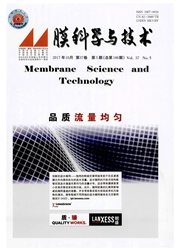

 中文摘要:
中文摘要:
采用浸渍法将不同端基的聚二甲基硅氧烷(PDMS)复合在聚砜基膜表面形成分离层,从而制备优先透醇渗透汽化复合膜.利用扫描电镜与接触角仪对复合膜表面的形貌和疏水性进行表征.结果表明,复合膜表面均致密均匀无缺陷,并且乙烯基PDMS(Vi-PDMS)复合膜具有更好的疏水性.通过对比两种不同端基PDMS复合膜的溶胀度以及成膜湿度对其性能的影响,发现Vi-PDMS复合膜比羟基PDMS(OH-PDMS)复合膜具有更好的耐溶胀性和抗湿性.考察了铸膜液中Vi-PDMS含量、进料液中乙醇浓度以及进料液温度对复合膜渗透汽化分离性能的影响.结果表明,当铸膜液中Vi-PDMS质量分数为15%,进料液中乙醇质量分数为5%,料液温度为60℃时,复合膜的渗透通量为857.1g/(m~2·h),分离因子为8.9.通过对复合膜的长期稳定性考察表明,该复合膜在700h内可稳定运行,具有一定的应用前景.
 英文摘要:
英文摘要:
The vinyl polydimethylsiloxane (Vi-PDMS) and hydroxyl PDMS(OH-PDMS) were used to prepare PDMS/polysulphone(PSf) Composite membranes for ethanol permselective pervaporation via dipcoating method. The morphology and hydrophobicity of the membranes were characterized by scanning electron microscopy (SEM) and contact angle (CA), respectively. The results showed that the surface of Vi-PDMS/PSf composite membranes were defect-flee with good hydrophobicity. The swelling degrees and effect of humidity on pervaporation performance of the different PDMS composite membranes were compared. It is demonstrated that the Vi-PDMS composite membrane had a better resistance to swelling and humidity than the OH-PDMS composite membrane. Therefore, the Vi-PDMS composite membrane has a potential application in ethanol permselective pervaporation. The effects of casting solution concentration, feed concentration, and feed temperature on the separation performance of the membranes were investigated. When the feed solution is mass fraction 5% ethanol/water mixtures at 60 ℃, the total permeate flux and separation factor were 857. 1 g/(m^2 · h) and 8. 9, respectively. Moreover, the composite membrane had a stable separation performance in 700 h, which indicated that it has a potential application in industry.
 同期刊论文项目
同期刊论文项目
 同项目期刊论文
同项目期刊论文
 Layer-by-layer assembled nanohybrid multilayer membranes for pervaporation dehydration of acetone&am
Layer-by-layer assembled nanohybrid multilayer membranes for pervaporation dehydration of acetone&am Poly(vinyl alcohol)-graphene oxide nanohybrid “pore-filling” membrane for pervaporation of toluene/n
Poly(vinyl alcohol)-graphene oxide nanohybrid “pore-filling” membrane for pervaporation of toluene/n One-step self-assembly fabrication of amphiphilic hyperbranched polymer composite membrane from aque
One-step self-assembly fabrication of amphiphilic hyperbranched polymer composite membrane from aque Metal-organic framework/poly(vinyl alcohol) nanohybrid membrane for the pervaporation of toluene/n-h
Metal-organic framework/poly(vinyl alcohol) nanohybrid membrane for the pervaporation of toluene/n-h Coordination-Driven In Situ Self-Assembly Strategy for the Preparation of Metal-Organic Framework Hy
Coordination-Driven In Situ Self-Assembly Strategy for the Preparation of Metal-Organic Framework Hy Highly stable “pore-filling” tubular composite membrane by self-crosslinkable hyperbranched polymers
Highly stable “pore-filling” tubular composite membrane by self-crosslinkable hyperbranched polymers Hybrid membranes of metal-organic molecule nanocages for aromatic/aliphatic hydrocarbon separation b
Hybrid membranes of metal-organic molecule nanocages for aromatic/aliphatic hydrocarbon separation b 期刊信息
期刊信息
